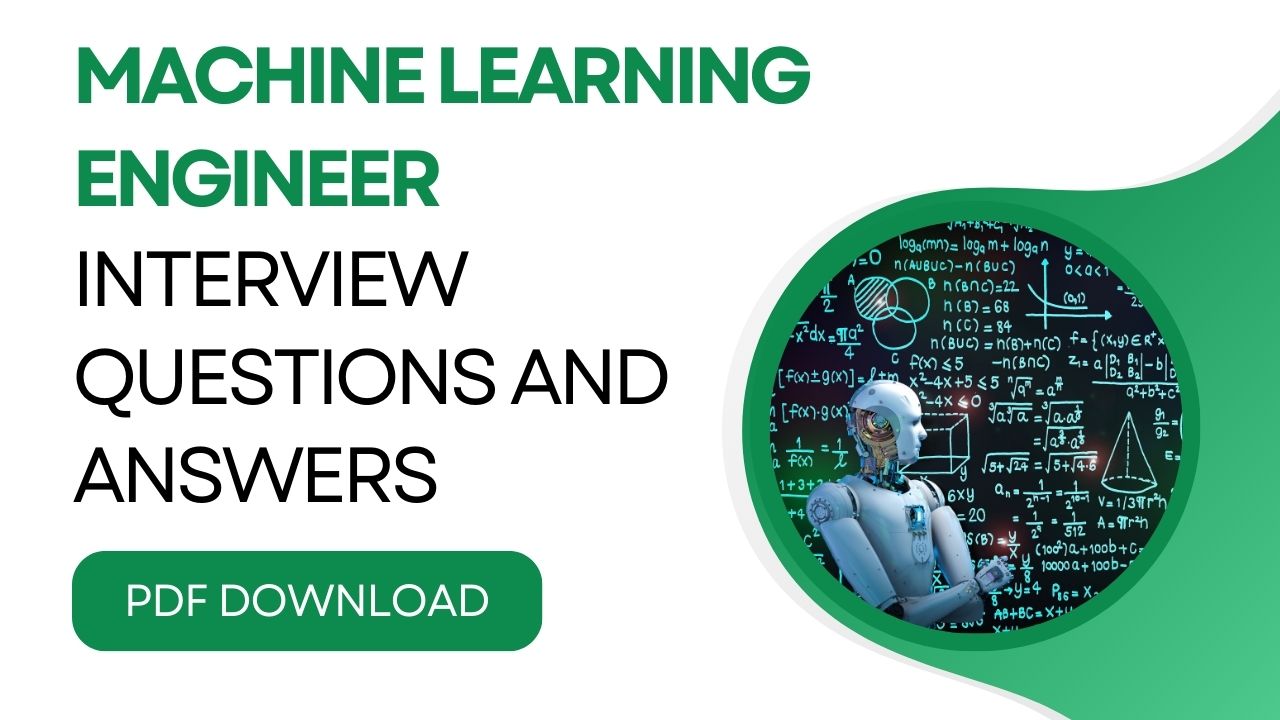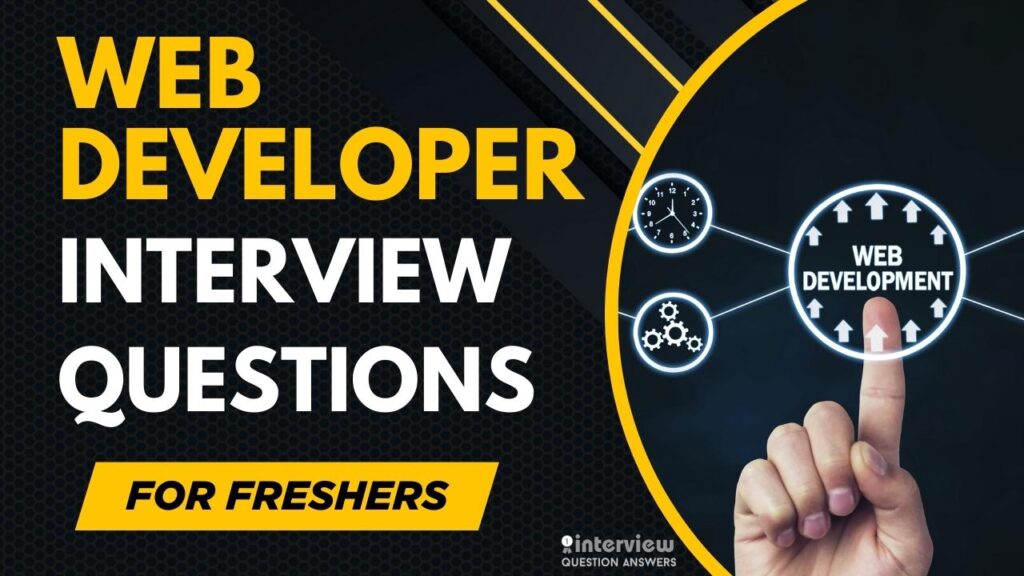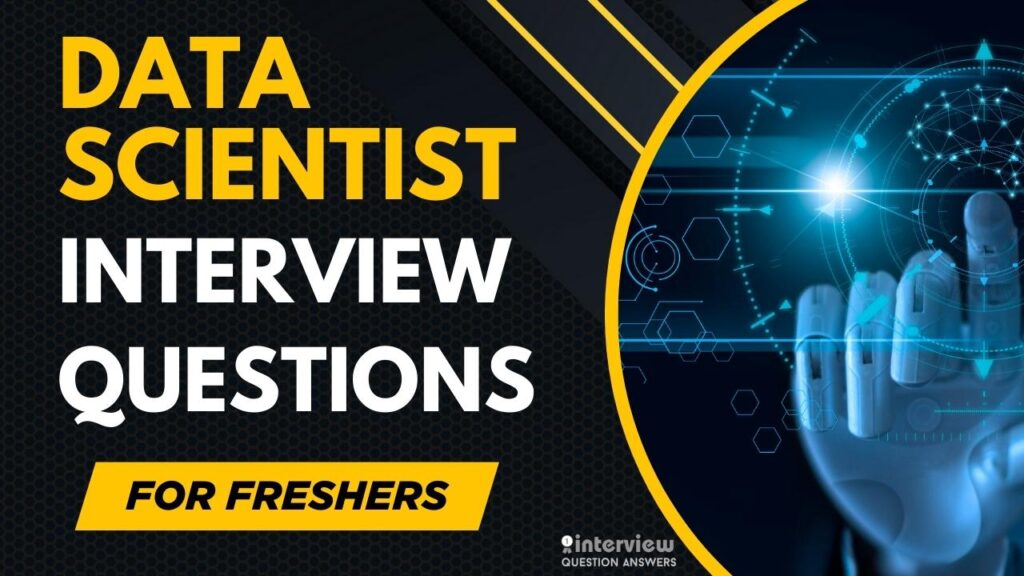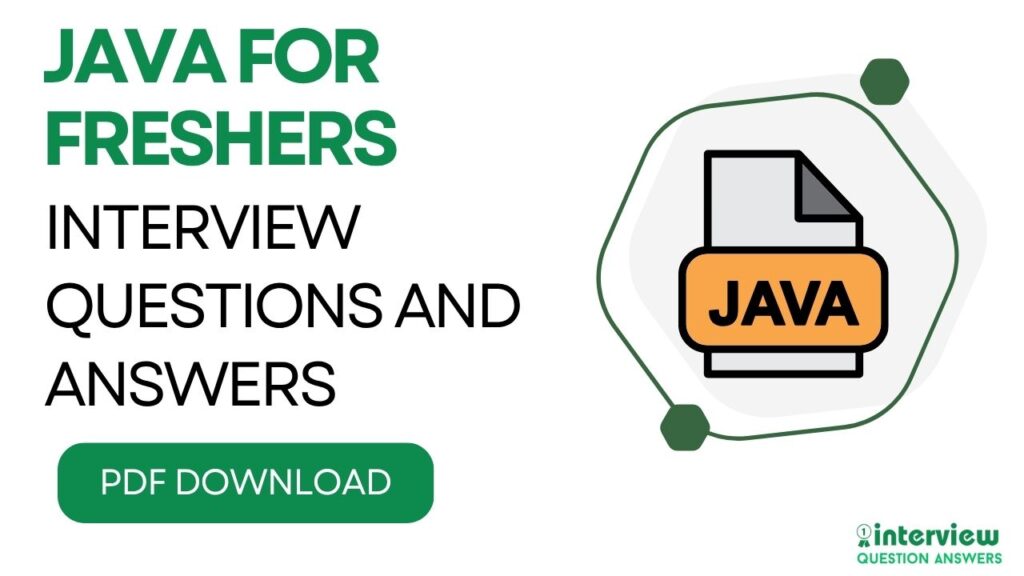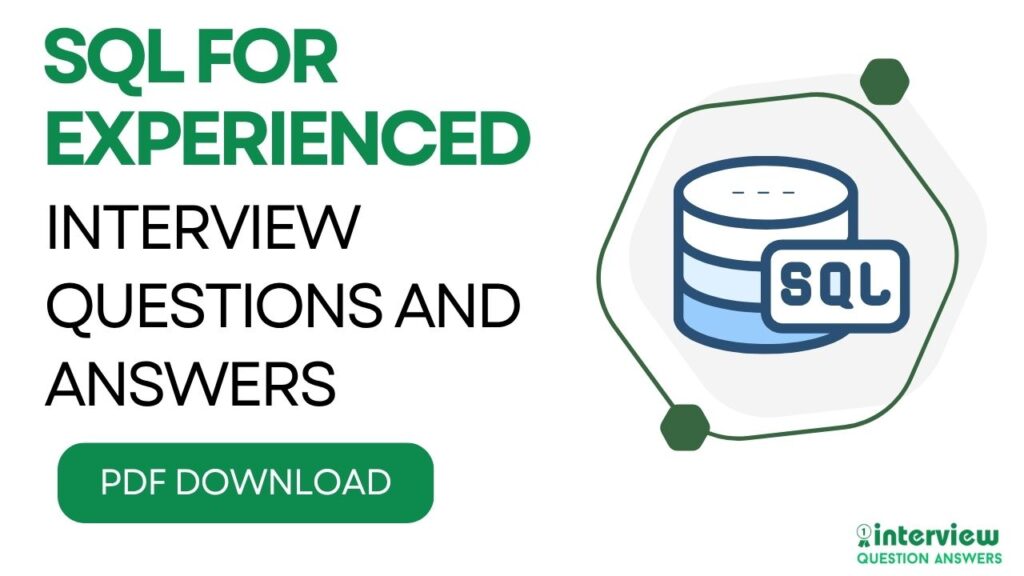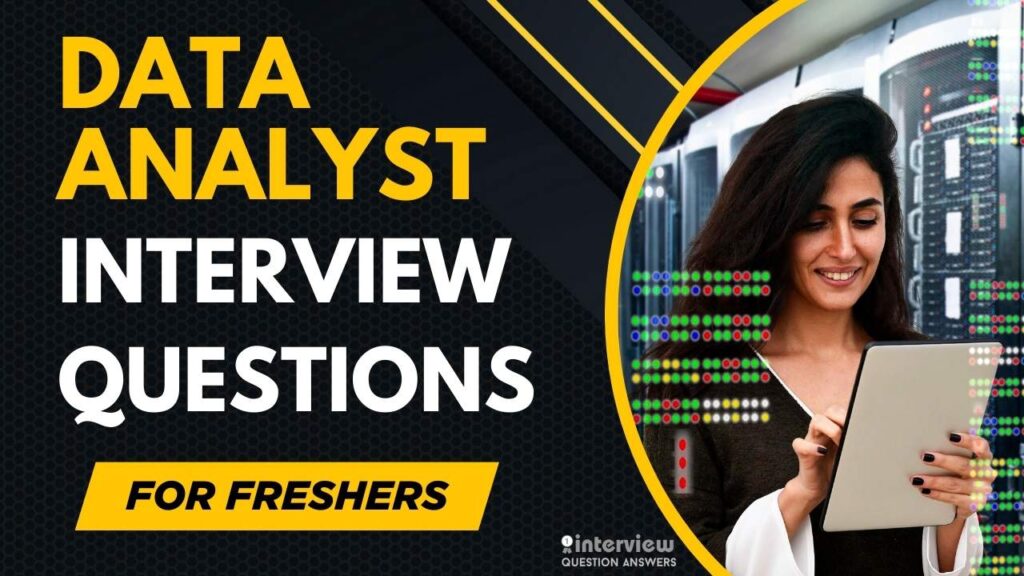A Machine Learning Engineer is a professional who focuses on designing and implementing machine learning applications. They build systems that can learn from and make predictions based on data.
This role involves a deep understanding of algorithms, programming, and data structures, as well as proficiency in programming languages such as Python. Machine Learning Engineers work with complex data sets, ensuring data quality and integrity while using data analysis tools to derive insights from data.
Preparing for a Machine Learning Engineer interview is crucial because these roles demand both theoretical understanding and practical problem-solving skills. Interviewers often test your knowledge of core ML concepts, coding ability, math skills, and your approach to solving real-world challenges like model bias, performance issues, or scaling models in production.
Here, we are sharing many popular Machine Learning Engineer interview questions and answers suitable for candidates ranging from freshers to experienced professionals. These questions include technical, real-life scenario-based queries to help you prepare better for your interview.
We are also providing PDF download so you can study offline and ensure you’re fully prepared for your next machine learning engineer interview.
Table of Contents
Machine Learning Engineer Interview Questions and Answers for Freshers PDF
For first we start from foundational concepts and progressing to slightly more complex topics.
1. What is the difference between supervised and unsupervised learning?
Answer:
- Supervised Learning: Uses labeled data (input-output pairs).
Example: Predicting house prices from features like area, location. - Unsupervised Learning: Uses only input data without labeled responses.
Example: Customer segmentation using clustering.
2. Explain overfitting and underfitting in machine learning.
Answer:
- Overfitting: The model performs well on training data but poorly on test data.
- Underfitting: The model performs poorly on both training and test data.
Example: Underfitting - too simple model
from sklearn.linear_model import LinearRegression
model = LinearRegression()3. What are hyperparameters in a machine learning model?
Answer:
Hyperparameters are settings used to control the learning process. They are not learned from the data.
Examples:
- Learning rate in gradient descent
- Number of trees in a Random Forest
- k in k-NN algorithm
4. What is the purpose of the train-test split?
Answer:
To evaluate how well the machine learning model generalizes to unseen data.
Typically, data is split like:
- 70% training
- 30% testing
from sklearn.model_selection import train_test_split
X_train, X_test, y_train, y_test = train_test_split(X, y, test_size=0.3)5. What is the difference between classification and regression?
Answer:
- Classification: Predicts a category (e.g., spam or not spam).
- Regression: Predicts a continuous value (e.g., price of a house).
6. What is cross-validation?
Answer:
A technique to evaluate the performance of a model by splitting data into several folds and validating it multiple times.
Example: K-Fold Cross-Validation
from sklearn.model_selection import cross_val_score
scores = cross_val_score(model, X, y, cv=5)7. Name some common performance metrics used in classification tasks.
Answer:
- Accuracy
- Precision
- Recall
- F1 Score
- ROC-AUC
8. What is a confusion matrix?
Answer:
A table used to describe the performance of a classification model.
| Predicted Positive | Predicted Negative | |
|---|---|---|
| Actual Positive | True Positive (TP) | False Negative (FN) |
| Actual Negative | False Positive (FP) | True Negative (TN) |
9. What is feature scaling and why is it important?
Answer:
It transforms data into a similar scale to improve model performance and convergence.
Common techniques:
- Min-Max Scaling
- Standardization (Z-score)
from sklearn.preprocessing import StandardScaler
scaler = StandardScaler()
X_scaled = scaler.fit_transform(X)10. What is the bias-variance trade-off?
Answer:
- Bias: Error due to overly simplistic models.
- Variance: Error due to overly complex models.
- The goal is to find a balance that minimizes total error.
11. Explain the concept of regularization.
Answer:
Regularization adds a penalty to the loss function to reduce model complexity and prevent overfitting.
Types:
- L1 (Lasso)
- L2 (Ridge)
12. What is the difference between bagging and boosting?
Answer:
| Technique | Description | Example |
|---|---|---|
| Bagging | Trains multiple models in parallel on different subsets | Random Forest |
| Boosting | Trains models sequentially, each correcting the previous one | XGBoost, AdaBoost |
13. What is PCA (Principal Component Analysis)?
Answer:
PCA is a dimensionality reduction technique that transforms features into a smaller set of uncorrelated variables called principal components.
from sklearn.decomposition import PCA
pca = PCA(n_components=2)
X_pca = pca.fit_transform(X)14. What are support vectors in SVM?
Answer:
Support vectors are data points closest to the decision boundary. They define the optimal hyperplane in Support Vector Machines.
15. How do decision trees make predictions?
Answer:
Decision trees split the data at nodes based on feature values. They traverse from the root to a leaf node to make predictions.
16. What is gradient descent?
Answer:
An optimization algorithm that adjusts model parameters to minimize the loss function.
# Simplified gradient descent update rule
theta = theta - learning_rate * gradient17. What are activation functions in neural networks?
Answer:
They introduce non-linearity. Common activation functions:
- ReLU
- Sigmoid
- Tanh
18. How is a confusion matrix different from an accuracy score?
Answer:
- Confusion Matrix: Gives detailed insights into true/false positives and negatives.
- Accuracy Score: Only gives the ratio of correct predictions.
19. What is an ROC curve?
Answer:
A graph showing the performance of a classification model at all classification thresholds.
- X-axis: False Positive Rate
- Y-axis: True Positive Rate
20. What is the curse of dimensionality?
Answer:
As the number of features increases, the data becomes sparse, making it harder for models to generalize. It affects both performance and computational efficiency.
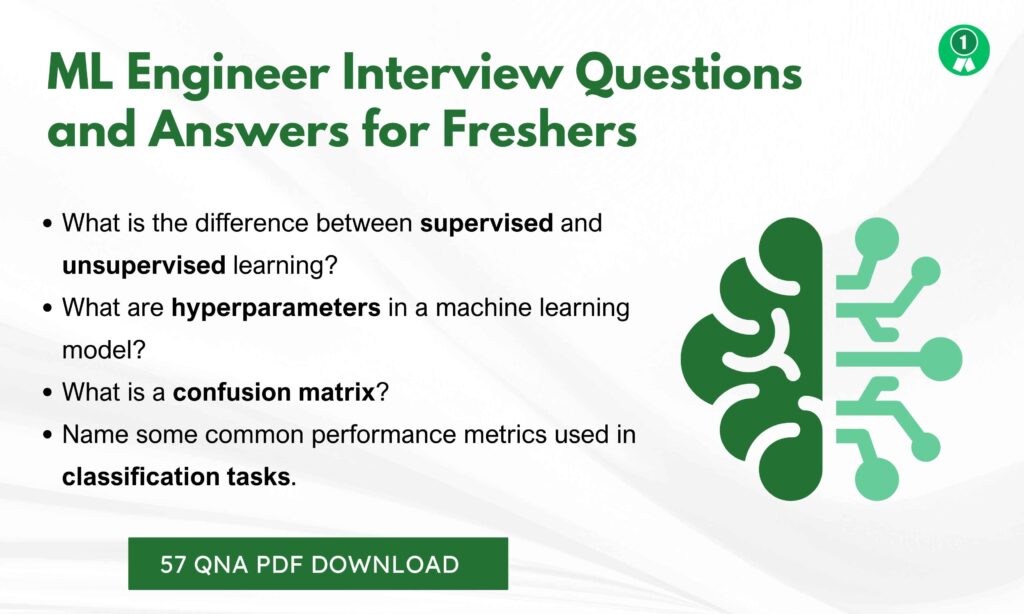
Also Check: Machine Learning Engineer Interview Questions for Freshers
Senior ML Engineer Interview Questions and Answers for Experience
These questions gradually increase in complexity and include practical insights, examples, and relevant Python snippets where needed. They focus on real-world problem-solving, deployment, system design, and advanced ML topics.
1. What are the key differences between batch learning and online learning?
Answer:
- Batch Learning: Trains the model on the full dataset at once.
- Online Learning: Trains the model incrementally using one data point or mini-batches.
Use Case:
- Batch: Traditional ML pipelines
- Online: Real-time recommendation systems, fraud detection
2. What are the steps to productionize a machine learning model?
Answer:
Key steps:
- Data preprocessing pipeline
- Model training and validation
- Model versioning and packaging
- Deployment via REST API or microservice
- Monitoring and retraining strategy
Tools often used: Docker, FastAPI, MLflow, Kubernetes
3. How do you monitor model drift in production?
Answer:
Methods to detect drift:
- Statistical tests (e.g., KS test, PSI)
- Model performance tracking (AUC, F1 score)
- Data distribution comparison
Tools: EvidentlyAI, WhyLabs, Prometheus + Grafana
4. What is the difference between model checkpointing and versioning?
Answer:
- Checkpointing: Saving intermediate model states during training (e.g., after each epoch).
- Versioning: Tracking changes across different trained models (e.g., v1.0, v1.1).
Tools: MLflow, DVC, TensorBoard, Weights & Biases
5. Explain how SHAP values work for model interpretability.
Answer:
SHAP (SHapley Additive exPlanations) is based on game theory. It assigns each feature an importance value for a specific prediction.
import shap
explainer = shap.Explainer(model, X_train)
shap_values = explainer(X_test)6. How do you choose between ensemble methods like Random Forest and Gradient Boosting?
Answer:
| Criteria | Random Forest | Gradient Boosting |
|---|---|---|
| Speed | Faster to train | Slower |
| Overfitting | Less prone | More prone |
| Performance | Good | Often better with tuning |
Use Random Forest for simpler or less sensitive problems. Use boosting for maximum accuracy.
7. What are embedding layers, and where are they useful?
Answer:
Embedding layers convert high-cardinality categorical features into dense vectors. Useful in:
- NLP (word embeddings)
- Recommender systems (user/item embeddings)
# Example in TensorFlow
tf.keras.layers.Embedding(input_dim=1000, output_dim=64)8. Describe your experience with model deployment pipelines.
Answer:
Typical deployment stack:
- Preprocessing: scikit-learn pipeline or custom transformers
- Serving: FastAPI, Flask, TensorFlow Serving
- Containerization: Docker, CI/CD pipelines
- Cloud: AWS SageMaker, GCP AI Platform
9. What are some techniques for handling imbalanced datasets?
Answer:
- Resampling: SMOTE, undersampling
- Algorithmic: Class weights, focal loss
- Evaluation: Use Precision, Recall, AUC instead of accuracy
10. How would you optimize a model for latency in a real-time application?
Answer:
Approaches:
- Model pruning or quantization
- Use faster algorithms (e.g., LightGBM vs. XGBoost)
- Convert to ONNX or TensorRT
- Serve on edge using TensorFlow Lite
11. What’s the role of feature engineering in ML pipelines?
Answer:
Feature engineering improves signal-to-noise ratio and model performance.
Includes:
- Interaction terms
- Aggregations
- Temporal features
- Encoding schemes
Use sklearn.pipeline for consistent transformations.
12. How do you perform hyperparameter tuning at scale?
Answer:
- GridSearchCV / RandomizedSearchCV for small-scale
- Optuna, Ray Tune, or Hyperopt for distributed tuning
import optuna
study = optuna.create_study(direction="maximize")
study.optimize(objective, n_trials=100)13. How do you handle data leakage?
Answer:
- Ensure test data is never used during training
- Avoid using future information (e.g., label leakage)
- Use proper feature selection and data split techniques (e.g., time-based split for temporal data)
14. What is your approach to A/B testing machine learning models?
Answer:
Steps:
- Randomly split users/groups
- Assign models (control vs. test)
- Define success metrics (CTR, conversion rate)
- Run test for a statistically significant duration
- Analyze results using p-values and confidence intervals
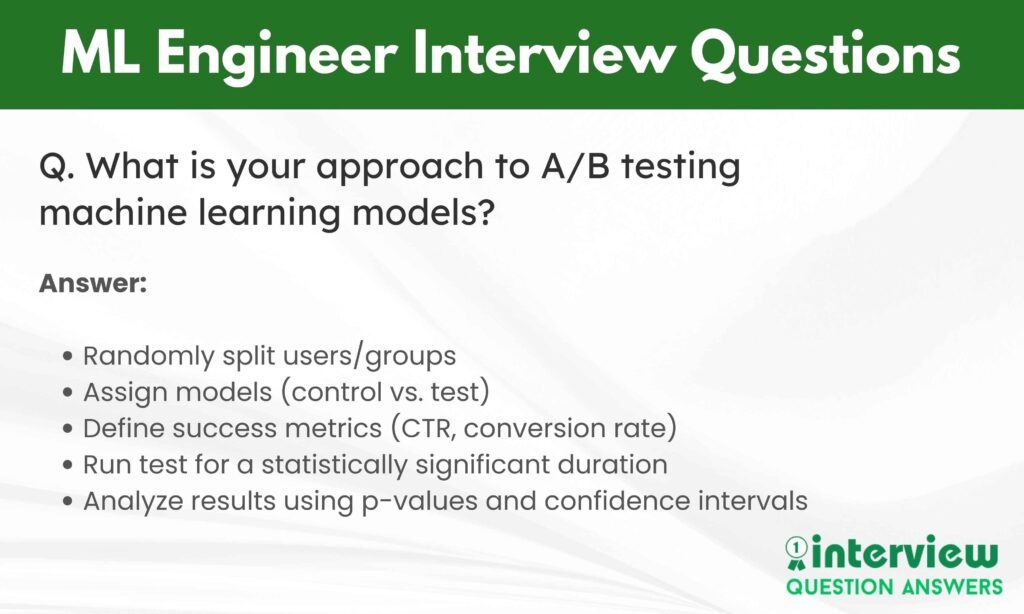
15. Explain the architecture of a large-scale recommendation system you’ve worked on.
Answer:
Typical architecture:
- Candidate generation (user/item embeddings)
- Ranking model (deep learning or gradient boosting)
- Serving layer (API + cache)
- Feedback loop (online learning or periodic retraining)
Use tools like FAISS, ANN libraries for fast retrieval.
16. How do you ensure reproducibility in ML projects?
Answer:
- Fix random seeds
- Use containerized environments
- Save versions of data, code, model, and dependencies
- Track experiments using MLflow or Weights & Biases
17. How do you debug a model with unexpectedly low performance?
Answer:
Checklist:
- Check data quality and preprocessing
- Examine label noise
- Look for data leakage
- Perform EDA on features
- Visualize model predictions vs. ground truth
- Use SHAP/Feature importance
18. What are key challenges in multi-label classification?
Answer:
- Labels can be sparse or highly correlated
- Evaluation is more complex (Hamming Loss, subset accuracy)
- Need proper threshold tuning
Approaches:
- Binary relevance
- Classifier chains
- Neural networks with sigmoid activation
19. How would you design a scalable ML system for real-time fraud detection?
Answer:
Design considerations:
- Stream processing with Kafka/Spark
- Low-latency model inference (ONNX, Triton)
- Feature store for historical data
- Continuous monitoring for drift
- Retraining schedule with feedback loop
20. How do you handle concept drift in time-series models?
Answer:
Strategies:
- Regular retraining on recent data
- Use adaptive models (e.g., online learning)
- Monitor metrics and drift indicators
- Segment model training by time windows
Also Check: Machine Learning Engineer Interview Questions for Experienced Professional
Ai ML Engineer Interview Questions and Answers
Ai ML questions are for candidates with some foundational knowledge in AI and machine learning.
1. What is the difference between rule-based AI and machine learning models?
Answer:
- Rule-based AI relies on manually written rules by domain experts.
- Machine learning models learn patterns from data without explicitly programmed rules.
Use case example:
- Rule-based: Expert systems in healthcare
- ML-based: Image classification, fraud detection
2. What is transfer learning, and why is it useful in AI?
Answer:
Transfer learning reuses a pretrained model on a new, but related task.
Benefits:
- Reduces training time
- Requires less data
- Improves performance
Example using a pretrained ResNet for classifying medical images.
from torchvision import models
model = models.resnet50(pretrained=True)3. How do you handle categorical features in a machine learning pipeline?
Answer:
Common techniques:
- One-Hot Encoding for low-cardinality features
- Label Encoding for ordinal variables
- Embeddings for high-cardinality features (common in deep learning)
from sklearn.preprocessing import OneHotEncoder
encoder = OneHotEncoder()
X_encoded = encoder.fit_transform(X[['category']])4. Explain the use of attention mechanisms in AI ML systems.
Answer:
Attention allows models to focus on relevant parts of the input sequence during prediction. It is commonly used in:
- NLP (e.g., Transformers, BERT)
- Image captioning
- Speech recognition
Benefits:
- Better handling of long sequences
- Improved context understanding
5. What are the differences between AI pipelines for training and inference?
Answer:
| Step | Training Pipeline | Inference Pipeline |
|---|---|---|
| Data Flow | Raw data to model training | Trained model to predictions |
| Components | Preprocessing, training, tuning | Preprocessing, model serving |
| Frequency | Periodic or scheduled | Real-time or on demand |
6. What is the role of reinforcement learning in AI systems?
Answer:
Reinforcement learning (RL) teaches agents to make decisions through trial and error using rewards.
Examples:
- Robotics control
- Game playing (e.g., AlphaGo)
- Dynamic pricing systems
Key concepts:
- Agent, Environment, Action, Reward, Policy, Value function
7. How do you choose the right evaluation metric for AI ML models?
Answer:
Depends on the problem type:
- Classification: Precision, Recall, F1 Score, ROC-AUC
- Regression: RMSE, MAE, R-squared
- Ranking: NDCG, MAP
Example:
- For fraud detection, F1 Score or Recall is preferred due to class imbalance.
8. How do you design an end-to-end AI ML pipeline?
Answer:
Typical pipeline components:
- Data ingestion
- Feature engineering
- Model training and validation
- Model packaging
- Model deployment and monitoring
Tools used:
- Airflow, Kubeflow, MLflow, TensorFlow Extended (TFX)
9. What are common challenges when deploying AI ML models in production?
Answer:
- Data drift and concept drift
- Latency and scalability
- Model versioning
- Dependency management
- Monitoring for performance and fairness
10. How do you ensure AI model fairness and mitigate bias?
Answer:
Steps to mitigate bias:
- Analyze data distributions and sensitive features
- Use fairness-aware algorithms
- Monitor fairness metrics (e.g., demographic parity, equal opportunity)
- Involve domain experts in auditing models
Tools:
- AIF360, Fairlearn
Zoho ML Engineer Interview Questions and Answer
There questions are specifically for candidates applying to Zoho’s machine learning roles. These questions increase in difficulty and focus on real-world ML implementation, model optimization, and practical use of AI tools within product environments.
1. What machine learning models are commonly used in SaaS product features like recommendation or automation?
Answer:
Common models include:
- Logistic Regression for binary classification
- Decision Trees and Random Forests for feature-driven decisions
- KNN or Collaborative Filtering for recommendations
- XGBoost or LightGBM for performance-sensitive applications
In Zoho-like products (CRM, Mail, Desk), these are used for lead scoring, email classification, ticket prioritization, etc.
2. How would you handle missing data in a customer analytics dataset?
Answer:
Approaches:
- Remove rows/columns if missingness is high
- Imputation techniques:
- Mean/median for numerical
- Mode or most frequent for categorical
- Model-based imputation using kNN or regression
from sklearn.impute import SimpleImputer
imputer = SimpleImputer(strategy='mean')
X_imputed = imputer.fit_transform(X)3. In a real-world Zoho CRM product, how can you ensure ML predictions are explainable to end users?
Answer:
Techniques:
- Use interpretable models (like logistic regression)
- Feature importance or decision tree paths
- SHAP values to explain individual predictions
Explainability is important for user trust in AI features like lead prediction, email routing, or sentiment analysis.
4. What are some model optimization techniques you have used in production?
Answer:
- Hyperparameter tuning with Optuna or GridSearchCV
- Early stopping to prevent overfitting
- Model pruning or quantization for speed
- Feature selection to reduce dimensionality
Example using Optuna:
import optuna
study = optuna.create_study(direction='maximize')
study.optimize(objective, n_trials=50)5. How would you design an ML pipeline to predict customer churn for Zoho products?
Answer:
- Data collection from CRM logs, interactions, usage
- Feature engineering: usage frequency, last login, support tickets
- Train-test split with time-aware validation
- Model selection: Logistic Regression or Random Forest
- Deployment using REST API or microservice
- Monitoring with performance dashboards
6. How do you handle concept drift in dynamic environments like SaaS?
Answer:
Concept drift happens when the relationship between input and output changes over time.
Handling strategies:
- Retrain models on recent data periodically
- Use adaptive models or online learning (e.g., River library)
- Monitor performance with rolling metrics
- Trigger alerts when drift is detected
FAQs: Machine Learning Engineer Interview
What does a Machine Learning Engineer do?
A Machine Learning Engineer develops algorithms and models that enable machines to learn from data and make predictions or decisions without being explicitly programmed. They handle tasks like data preprocessing, model training, evaluation, optimization, and deploying models into real-world applications such as recommendation engines, fraud detection, or autonomous systems.
What are the key skills required to become a Machine Learning Engineer?
A strong ML engineer should have proficiency in Python, data structures, statistics, and machine learning algorithms. Experience with frameworks like TensorFlow, PyTorch, or scikit-learn, and knowledge of SQL, cloud platforms (AWS, GCP, Azure), and model deployment tools is also important.
What challenges might you face during a Machine Learning job or interview?
Common challenges include understanding complex business problems, working with messy or unbalanced data, choosing the right model, avoiding overfitting, and optimizing performance. During interviews, candidates often struggle with system design questions, explaining model decisions, and demonstrating real-world problem-solving under time pressure.
How can I prepare for a Machine Learning Engineer interview?
Start by revising key ML concepts like supervised/unsupervised learning, model evaluation metrics, bias-variance tradeoff, and feature engineering. Practice coding problems, understand the mathematics behind ML (linear algebra, probability, calculus), and study system design. Also, review your past projects in detail and prepare to explain your role and decisions.
What is the average salary of a Machine Learning Engineer in the USA?
The average salary for a Machine Learning Engineer in the USA ranges from $100,000 to $160,000 per year, depending on experience, location, and company. Senior-level engineers at top tech companies can earn $180,000 or more, especially when including bonuses and stock options.
Which companies are known for hiring Machine Learning Engineers?
Top companies hiring ML Engineers include:
Google, Amazon, Meta, Apple, Microsoft, NVIDIA, Netflix, Uber, IBM, OpenAI
These companies often work on advanced AI applications and offer high-impact ML roles.
Do I need a degree to become a Machine Learning Engineer?
While many roles prefer a degree in Computer Science, Data Science, or Mathematics, it’s not always required. Candidates with strong portfolios, hands-on experience, certifications (like Google ML, Coursera ML, or AWS ML), and contributions to open-source projects can also secure jobs without a formal degree.
Conclusion
Preparing for a Machine Learning Engineer interview requires a solid mix of theoretical knowledge, coding expertise, and practical application skills. In this article, we’ve covered a wide range of interview questions and answers designed to help both freshers and experienced professionals succeed.
Starting from basic machine learning concepts to real-life technical scenarios involving model deployment, performance tuning, and data handling challenges.
We’ve also provided a downloadable PDF so you can prepare offline, revise anytime, and walk into your interview fully ready.
Similar Interview Guides:

